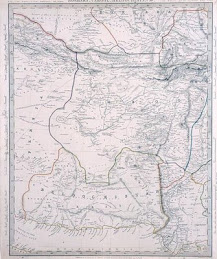The world's new powers discover the old ethnonationalisms.
After his great victory in Desert Storm, George H.W. Bush went before the United Nations to declare the coming of a New World Order. The Cold War was yesterday. Communism was in its death throes. The Soviet Empire had crumbled.
The Soviet Union was disintegrating. Francis Fukuyama was writing of The End of History. Savants trilled about the inevitable triumph of democratic capitalism.
Yet, in 2012, sectarianism, tribalism and nationalism are all resurgent, reshaping a world where U.S. power and influence are visibly receding.
Syria is sinking into a war of all against all that may end with a breakup of the nation along ethno-sectarian lines–Arab, Druze, Kurd, Sunni, Shia and Christian. Iraq descends along the same path.
A U.S. war with Iran could end with a Kurdish enclave in Iran’s
northwest tied to Iraqi Kurdistan, Iran’s Azeri north drifting toward
Azerbaijan, and a Balochi enclave in the south linked to Pakistan’s
largest province, Balochistan, leaving Iran only Persia.
The Middle and Near East seem to be descending into a Muslim Thirty
Years’ War of Sunni vs. Shia. Out of it may come new nations whose names
and borders were not written in drawing rooms by 19th- and 20th-century
European cartographers, but in blood.India, too, is feeling the tremors. Ethnic violence in the Assam region has sent hundreds of thousands fleeing in panic.
In East Asia, ethnonationalism, fed by memories from the 20th century, is igniting clashes among former Cold War allies.
China’s claim to the Spratly, Paracel and other islands in the South China Sea puts Beijing in conflict with Hanoi, which welcomes U.S. warships back to Cam Ranh Bay. Were not these the same people we bombed and blasted not so long ago?
Twenty years ago, Manila ordered the U.S. Navy out of Subic Bay, which had been home to the U.S. Pacific Fleet almost since the Spanish-American war. Now Manila is inviting America back.
Why? China is claiming islets, atolls and reefs 1,000 miles from the Chinese mainland, but only 100 miles from the Philippine coast.
To annex what could be a mother lode of oil, gas and minerals in the South China Sea, China is stoking the ethnonationalism of its own people.
Yet, a fear of ethnonationalism is behind Beijing’s repression of Tibetans and Uighurs, whose regions are being inundated with Han Chinese, just as Josef Stalin flooded Estonia, Lithuania and Latvia with Russians after annexing them in 1940.
“All is race; there is no other truth,” wrote Benjamin Disraeli in his novel “Tancred.” Beijing behaves as if it believes Disraeli was right.
China now claims Japan’s Senkaku islands, which Beijing calls the Diaoyu. South Korea claims Japan’s Takeshima in the East China Sea, which Seoul calls Dokdo. Here history enters the quarrel.
In 1908, in the Root-Takahira Agreement, Theodore Roosevelt agreed to Tokyo’s annexation of Korea in return for recognition of U.S. annexation of the Philippines.
Root-Takahira is a black page in Korean history. For Japan’s occupation ran through World War II, when Korean girls were forced into prostitution as “comfort women” for Japanese troops. Tokyo and Seoul were Cold War allies, but these old wounds never healed.
The visit to Dokdo last week by South Korean President Lee Myung-bak, cheered by his countrymen, represented a rejection of Japan’s claim and an assertion that the islets belong to Korea. Russia, too, has now gotten into the islands game.
Two days after the United States dropped the bomb on Hiroshima, the day before Nagasaki, Stalin declared war and sent Russian troops to seize the Kuril islands north of Japan and expel the population. Japan still claims the four southernmost islands of the Kuril chain.
Russian Prime Minister Dmitry Medvedev just stoked the flames of tribalism in both nations by visiting the Kuril island that is closest to Japan.
With China, South Korea and Russia asserting claims and making intrusions on islands Japan regards as sacred territory, Tokyo is taking a new look at rebuilding her armed forces.
On Aug. 15, the anniversary of Japan’s surrender in World War II, two cabinet ministers visited the Yasukuni Shrine to the World War II dead. A new nationalism is rising in the Land of the Rising Sun. China and Russia may be nuclear powers, but Japan could join that club swiftly should she chose to do so.
The bipolar world of the Cold War is history. The new world order, however, is not the One World dreamed of by Wilsonian idealists. It is a Balkanizing world where race, tribe, culture and creed matter most, and democracy is seen not as an end in itself but as a means to an end–the accretion of power by one’s own kind to achieve one’s own dreams.
As Abraham Lincoln said in another time, when an old world was dying and a new world was being born, “As our situation is new, let us think and act anew.”
Patrick J. Buchanan is a founding editor of TAC and the author of “Suicide of a Superpower: Will America Survive to 2025?” Copyright 2012 Creators.com.
http://www.theamericanconservative.com/articles/new-world-disorder/










































No comments:
Post a Comment